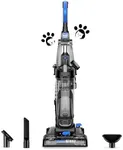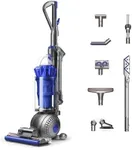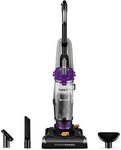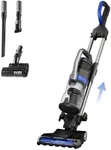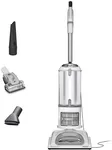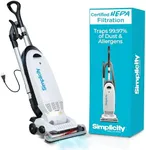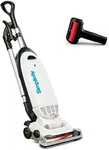Buying Guide for the Best Upright Vacuums
Choosing an upright vacuum can seem overwhelming with so many options and features available. It’s important to start by understanding your cleaning needs, the surfaces in your home, and how the features of different models can make cleaning easier for you. Focusing on the key specifications and how they relate to your everyday use will help you pick a vacuum that’s both effective and convenient.Suction PowerSuction power refers to how strongly the vacuum can pull in dust, dirt, and debris from surfaces. This is important because higher suction power generally means better cleaning, especially on carpets or thick rugs. You’ll see values measured in air watts or simply advertised as strong/regular suction. For homes with lots of carpets, higher suction is useful, but for mainly hard floors, moderate suction may be sufficient. Suction power over time can also depend on how often you maintain the filters and dust bin.
Filtration SystemThe filtration system determines how well the vacuum traps dust and allergens instead of releasing them back into the air. This is especially important for allergy sufferers or homes with pets. HEPA filters capture very fine particles and are ideal for cleaner air, while standard filters are adequate for basic dust and dirt. Consider a vacuum with a higher-quality filter if you are sensitive to dust or want to reduce airborne particles.
WeightWeight tells you how heavy the vacuum is, which influences how easy it is to move around and use, especially if you need to carry it upstairs or have limited mobility. Lighter models (usually under 12 pounds) are easier for frequent or extended use, while heavier models may feel sturdier and sometimes have larger capacity but can be harder to maneuver.
Corded vs CordlessThis specification is about whether the vacuum requires plugging into a power outlet (corded) or runs on a rechargeable battery (cordless). Corded vacuums tend to offer continuous power and are good for longer cleaning sessions, while cordless versions provide more freedom to move but require recharging and have a limited run time. If you have larger areas to clean at once, corded might suit you better, while smaller homes or quick cleanups can benefit from cordless convenience.
Brush Roll TypeThe brush roll is what agitates and lifts dirt from carpets. Some upright vacuums have fixed brush rolls that are always spinning, while others allow you to switch the brush roll on or off depending on the surface. Models with an adjustable or multi-surface brush are more versatile, making them good if you have a combination of carpeted and hard floors.
Dust CapacityThis refers to the size of the vacuum’s dust bin or bag and determines how often you’ll need to empty it. Larger capacity means fewer emptying trips, which is useful for bigger homes or people with pets that shed. If storage space is an issue or you don’t mind frequent emptying, a smaller dust bin may be okay.
Attachments and ToolsMany upright vacuums come with extra tools such as crevice wands, upholstery brushes, or pet hair attachments. These make it easier to clean furniture, stairs, and tight spots. If you have pets, children, or a variety of surfaces, choosing a vacuum with a range of attachment options can make your cleaning more effective and flexible.
Noise LevelNoise level is how loud the vacuum is during use, typically measured in decibels. If you need to clean while others are home or are sensitive to noise, look for quieter models. Loud vacuums can be disruptive, especially in small or echo-prone spaces. Consider this feature if you want a more comfortable cleaning experience.


